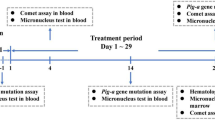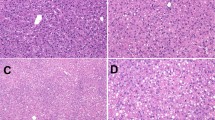Abstract
Groups of male and female F-344 rats and B6C3F1 mice were exposed to 15000 ppm ethyl chloride (monochloroethane, ECL) or to air for 5 days (6 h/day). In this report, features of GSH-dependent ECL metabolism in the animals are described. A concurrent report describes the features of the cytochrome P450-dependent oxidative ECL metabolism (Fedtke et al. 1994). ECL conjugation to GSH in hepatic cytosolic fractions was catalyzed by GSHS-transferases. The specific activities were 0.16±0.03 and 0.17±0.01 nmol ECL conjugated/(min mg protein) in air treated male and female F-344 rats, respectively. These activities were not significantly altered by the ECL treatment. Compared with rats, the GSH-transferase activities towards ECL were generally higher in male and female B6C3F1 mice (0.71±0.19 and 1.01±0.19, respectively) and were slightly decreased by ECL treatment. The ECL conjugation to GSH resulted in a marked reduction of the GSH concentration in the lung and the uterus after 5 days of exposure. In contrast, liver and kidney GSH concentrations were affected only to a minor degree. FormedS-ethyl-glutathione was converted to the mercapturic acidS-ethyl-N-acetyl-L-cysteine (SENACys), which was detected in the urine of both species. In addition, the non-acetylated intermediateS-ethyl-L-cysteine (SECys) was excreted in mouse urine but not in rat urine. The cumulative amounts of SENACys and SECys excreted after 5 days were up to fivefold higher in mice than in rats and the excretion kinetics were species specific. The results are discussed with regard to a 2 year bioassay with F-344 rats and B6C3F1 mice exposed to 15000 ppm ECL (NTP 1989). In this bioassay, a species specific carcinogenic response in the mouse uterus was observed. It is proposed that the mechanism of tumor induction is a high dose phenomenon and more likely related to the GSH conjugation than to the oxidative metabolism or to possible genotoxic effects of ECL or its metabolites.
Similar content being viewed by others
References
Barnsley EA, Eskin NAM, James SP, Waring RH (1969) The acetylation ofS-alkylcysteines by the rat. Biochem Pharmacol 18: 2393–2401.
Bergmeyer HV (1983) Methods of enzymatic analysis, vol. VIII, VCH Verlagsgesellschaft, Weinheim, Germany, pp. 522–529.
Coles B, Ketterer B (1990) The role of glutathione and glutathione transferases in chemical carcinogenesis. Crit Rev Biochem Mol Biol 25: 47–70
D'Souza RW, Francis WR, Andersen ME (1988) Physiological model for tissue glutathione depletion and increased resynthesis after ethylene dichloride exposure. J Pharmacol Exp Ther 245: 563–568
Ebert R, Fedtke N, Certa H, Wiegand HJ, Régnier JF, Marshall R, Dean SW, Kirkland DJ (1994) Genotoxicity studies with chloroethane. Mutat Res (in press)
EPA (1987) Mutagenic activity of chloroethane in the salmonella/microsome assay with attachments, submitted to EPA by E. I. Dupont de Nemours & Co., Doc. No. 86-870000986, Microfiche No. OTS 0517038
Fedtke N, Certa H, Ebert R, Wiegand HJ (1994) Species differences in the biotransformation of ethyl chloride: I. Cytochrome P450-dependent metabolism. Arch Toxicol 68: 158–166
Gargas ML, Burgess RJ, Voisard DE, Cason GH, Andersen ME (1989) Partition coefficients of low molecular weight volatile chemicals in various liquids and tissues. Toxicol Appl Pharmacol 98: 87–99
Gargas ML, Clewell HJ III, Andersen ME (1990) Gas uptake inhalation techniques and the rates of metabolism of chloromethanes, chloroethanes, and chloroethylenes in the rat. Inhal Toxicol 2: 295–319
Gerin M, Tardif R (1986) UrinaryN-acetyl-S-2-hydroxyethyl-L-cysteine in rats as biological indicator of ethylene oxide exposure. Fundam Appl Toxicol 7: 419–423
Hulbert PB, Hamoodi NM (1990) Reactivity of chloronitrobenzenes towards glutathione under physiological conditions: the relationship between structure and reaction rate. J Pharmacol Biomed Anal 8: 1009–1013
Jäger R (1988) Untersuchungen zum Metabolismus und zum toxikologischen Wirkmechanismus von Methylhalogeniden (Methylchlorid, Methylbromid). Dissertation, Justus-Liebig-Universität Gießen, Germany
Jones AR, Walsh DA (1980) The fate ofS-propylcysteine in the rat. Xenobiotica 10: 827–834
Koskelo K (1983) Isoelectric focusing of glutathioneS-transferases: comparison of acidic transferases from human liver, kidney, lung, spleen, and placenta. Scand J Clin Lab Invest 43: 133–139
Landry TD, Ayres JA, Johnson KA, Wall JM (1982) Ethyl chloride: a two-week inhalation toxicity study and effects on liver non-protein sulfhydryl concentrations. Fundam Appl Toxicol 2: 230–234
Lowry OH, Rosebrough NJ, Farr AC, Randell RJ (1951) Protein-measurement with the folin phenol reagent. J Biol Chem 193: 265–275
Marchand DH, Reed DJ (1989) Identification of the reactive glutathione conjugateS-(2-chloroethyl)glutathione in the bile of 1-bromo-2-chloroethane-treated rats by high-pressure liquid chromatography and precolumn derivatization witho-phthalaldehyde. Chem Res Toxicol 2: 449–454
Milman HA, Story DL, Riccio ES, Sivak A, Tu AS, Williams GM, Tong C, Tyson CA (1988) Rat liver foci and in vitro assays to detect initiating and promoting effects of chlorinated ethanes and ethylenes. Ann NY Acad Sci 534: 521–530
NTP (1989) Technical report series No. 346. Toxicology and carcinogenesis studies of chloroethane (ethyl chloride, CAS No. 75-00-3) in F344/N rats and B6C3F1 mice. National Toxicology Program, NIH Publication No. 90-2801, US Department of Health and Human Services
Pottenger LH, Landry TD, Bus JS (1991) Species-specific and dose dependent non-protein sulfhydryls (NPSH) depletion in female mice and rats after inhalation exposure to ethyl chloride. Toxicologist 11: 348
Pottenger LH, Nieusma JL, Bus JS (1992) Species-dependent disposition and toxicity of ethyl chloride in female mice and rats. Toxicologist 12: 424
Riccio E, Griffin A, Mortelmans K (1983) A comparative mutagenicity study of volatile halogenated hydrocarbons using different metabolic activation systems. Environ Mutagen 5: 472
Tardif R, Goyal R, Brodeur J, Gerin M (1987) Species differences in the urinary disposition of some metabolites of ethylene oxide. Fundam Appl Toxicol 9: 448–453
Author information
Authors and Affiliations
Rights and permissions
About this article
Cite this article
Fedtke, N., Certa, H., Ebert, R. et al. Species differences in the biotransformation of ethyl chloride. Arch Toxicol 68, 217–223 (1994). https://doi.org/10.1007/s002040050060
Received:
Accepted:
Issue Date:
DOI: https://doi.org/10.1007/s002040050060




